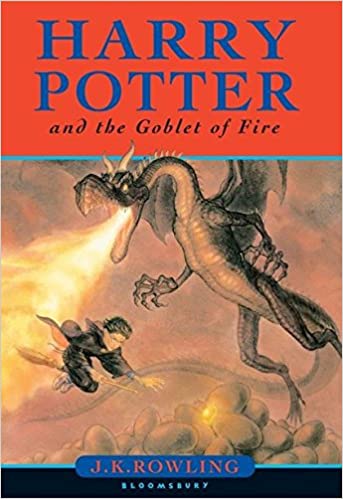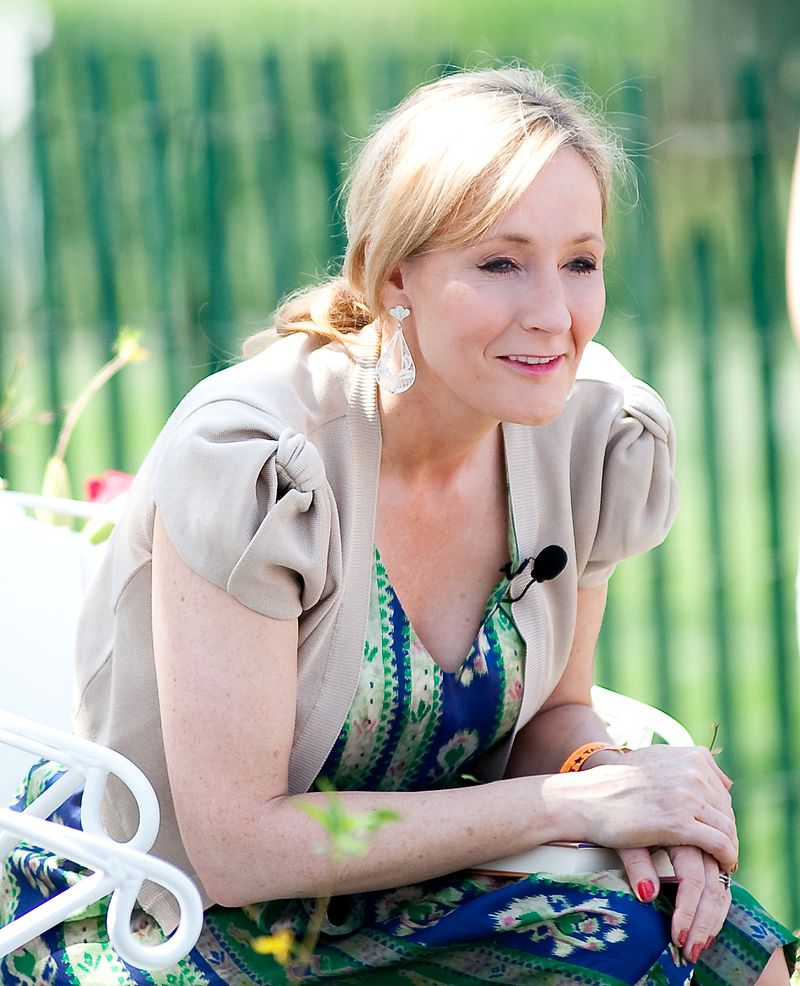Title of the work
Country of the First Edition
Country/countries of popularity
Original Language
First Edition Date
First Edition Details
J. K. Rowling, Harry Potter and the Goblet of Fire. London: Bloomsbury, 2000, 636 pp.
ISBN
Awards
2001 – Hugo Award for Best Novel;
2001 – Whitaker's Platinum Book Award;
2001 – Scottish Arts Council Book Award;
2002 – Indian Paintbrush Book Award.
Source: Siue.edu (accessed: April 4, 2021).
Genre
Fantasy fiction
School story*
Target Audience
Crossover
Cover

Cover of the first edition. Courtesy of Bloomsbury Publishing.
Author of the Entry:
Anna Mik, University of Warsaw, anna.m.mik@gmail.com
Peer-reviewer of the Entry:
Elżbieta Olechowska, University of Warsaw, elzbieta.olechowska@gmail.com
Elizabeth Hale, University of New England, ehale@une.edu.au

Portrait of J. K. Rowling, photographed by Daniel Ogren on April 5, 2010. The file is licensed under the Creative Commons Attribution-Share Alike (accessed: May 25, 2018).
J. K. Rowling
, b. 1965
(Author, Illustrator)
Joanne Kathleen Rowling, was born July 31, 1965 in Yate, Gloucestershire, England. She graduated from the University of Exeter with a degree in French and Classics, she is considered a writer with classical background. After publishing the first Harry Potter book in 1997, she gradually became the best known author of all time.
The Harry Potter septology (1997–2007), is one of the most successful and popular series in the history of children’s literature (Harry Potter and the Philosopher’s Stone sold in 107 million copies). It may be argued that, from the very beginning, the author herself had to expand this world, fill the gaps, and explain all the rules– not only by discussing some issues (later on – mainly on Twitter) or giving guidelines in the interviews but by creating her website Pottermore. Once it was an online platform, where fans could read the series simultaneously with Rowling’s commentary and additions. Now it serves more as commercial space, although Rowling still adds some new elements (e. g. the short history of magical schools in USA).
To give to the devoted fans of Harry something that would allow them to feel the magical bond with the world they want to be a part of she created three books that now exist in both the secondary world of Hogwarts and the primary world where the reader can have a copy in their own hands.
HP Series Spin-offs:
Quidditch Through the Ages by Kennilworthy Whisp (2001), Fantastic Beasts and Where to Find Them by Newton Scamander (2001) and The Tales of Beedle the Bard (2007)* are allegedly copies of books from the world of Harry Potter which include different literary genres and publication formats: history of sport, bestiaries, and collections of fairy tales. These books are not part of the septology, but they provide complementary information about sports, animals and animal-like creatures, and fairy-tales of the Wizarding World. Additionally, they can be interpreted as a device to help convince readers of the reality of the magical world. In these three books, as in the series sensu stricto, J. K. Rowling plays on various levels with great literary traditions, using one of the many features of postmodern literature.
Bio prepared by Anna Mik, University of Warsaw, anna.m.mik@gmail.com
* Hand-written copies were released in 2007, printed ones in 2008.
Adaptations
Film adaptation: Dir. Mike Newell, Harry Potter and the Goblet of Fire, Warner Cinema, 2005.
Video game based on the novel and the movie: Harry Potter and the Goblet of Fire, published by Electronic Arts, composer: Jeremy Soule, 2005.
Translation
Multiple languages.
Sequels, Prequels and Spin-offs
Summary
Harry Potter and the Goblet of Fire is the fourth book in the series by J. K. Rowling about a young wizard, learning magic at Hogwarts and, in almost every book, battling the antagonist of the series, Lord Voldemort. In the previous part of the series, Harry Potter and the Prisoner of Azkaban, Harry learns about the prophecy concerning Voldemort, until now considered dead or missing. According to the prediction: "The Dark Lord will rise again with his servant's aid, greater and more terrible than ever before" (p. 238). The Goblet of Fire reveals how the Dark Lord carried out his plan of rebirth.
The evil wizard takes advantage of the Triwizard Tournament – an international competition happening at Hogwarts - to lure Harry Potter into a maze (walking through it is the last of three tasks in the competition) and ultimately, use the boy for his own purposes. In the graveyard in his hometown, Voldemort performs a dark ritual and materializes in a human-like form. This is a breakthrough moment in the series, as the following parts are centred on the theme of uniting the Wizarding World and defeating the Dark Lord once and for all.
Nonetheless, throughout most of The Goblet of Fire, the reader is unaware that the competition is controlled by Lord Voldemort's follower, Barty Crouch Jr., disguised as one of the school professors and aurors, Alastor "Mad-Eye" Moody. The story is told in an adventure mode, revealing new aspects of the world of magic: Quidditch World Cup; the Triwizard Tournament, the life and customs of house elves; the existence of magical schools abroad; magical wild animals, etc.
Analysis
Compared to the other books of the series, set in a rather fairy-tale aesthetics, this one could be classified as a young adult fantasy, a darker and more in-depth storytelling. The book is rich in classical motifs, as well as those originated in other cultures (Anglo-Saxon, Slavic, Nordic, and so on). In this entry, only the former will be highlighted, omitting other cultural influences present in the novel.
The first classical theme that appears in the book is associated with mythical monsters – the sirens. Two types of fantastic beasts of the Wizarding World have features associating them with sirens: the Veela and the merpeople. The Veela appear for the first time prior to the Quidditch Cup Match – as the Bulgarian Team Mascots: "Veela were women… the most beautiful women Harry had ever seen… except that they weren't – they couldn't be – human. This puzzled Harry for a moment, while he tried to guess what exactly they could be; what could make their skin shine moon-bright like that, or their white-gold hair fan out behind them without wind…" (p. 93). Their seductive powers are revealed just in the next paragraph: "The Veela had started to dance, and Harry's mind had gone completely and blissfully blank. All that mattered in the world was that he kept watching the Veela, because if they stopped dancing, terrible things would happen…" (p. 94). In this particular context – creatures being associated with Bulgarian, hence, Slavic heritage – the Veela belong to the Slavic mythology rather than classical,* as Slavic culture is rich in numerous cases of female monsters who seduce young men and put them in danger. However, during the game, when the Bulgarian team are losing the match, another motif appears: "[…] their [Veela's] faces were elongating into sharp, cruel-beaked bird heads, and long, scaly wings were bursting from their shoulders" (p. 101). Just from this short description it might be deduced that Rowling was inspired here by the idea of the classical sirens, known from Homer's Odyssey. Scales on their wings might also indicate the connection to water, where sirens hunted, looking for lost sailors.
Other creatures possibly inspired by sirens from classical mythology are the merpeople. They live at the bottom of the Great Lake nearby the Hogwarts castle. Usually, they do not interfere in human affairs, here however, they play an important part. In the second round of the Triwizard Tournament, they guard friends of the contestants, whose task is to free them from the bottom of the lake and return to the surface in one hour. The reader learns that the merpeople's voices can only be heard under water – otherwise, it is just an annoying, high-pitched noise. In the water, merpeople's songs are beautiful and mesmerizing – just like the voice of the ancient sirens. Even though in the case of these creatures, many other mythical and legendary beasts could have inspired Rowling, the siren reference remains strong.
Another classical motif appears in the third and the last round of the competition, when the contestants have to get through the maze to find the Triwizard Cup. The maze itself could be referred to the Labyrinth designed by Daedalus, especially since it is very dangerous as well. Even though Harry does not find the Minotaur in the maze, he encounters (among other creatures) the sphinx. She says to the boy that the shortest way lies right next to her, however, Harry needs to solve a riddle first. The task ends with a success and the wizard can continue his crossing of the maze.
The students are teenagers now and start to pair-up with each-other. There are no explicit sexual themes in the novel, however, the presence of sirens (great seductresses) might imply such a content in a metaphorical way. The same is true of the maze. Its symbolic power is to be connected to the motif of growing-up, which is often mysterious, uncertain, and dangerous – just like the Labyrinth. As is the case in every book, J.K. Rowling also packs The Goblet of Fire with many classical references. They not only educate the readers, but also bring the classical world to life, as very attractive to young people.
*See Anna Mik, "Demoniczna istota we wnętrzu pięknego kwiatu. Fleur Delacour jako spadkobierczyni uroków wili", in W. Kostecka, M. Skowera, eds., Harry Potter: Fenomen Społeczny, Zjawisko Literackie, Ikona Popkultury, Warszawa: SBP, 2014, 129–137.
Further Reading
Mik, Anna, "Demoniczna istota we wnętrzu pięknego kwiatu. Fleur Delacour jako spadkobierczyni uroków wili", in W. Kostecka, M. Skowera, eds., Harry Potter: Fenomen Społeczny, Zjawisko Literackie, Ikona Popkultury, Warszawa: SBP, 2014, 129–137.
Mik, Anna, "Magizoology: the magical creatures studies. J. K. Rowling’s postulates on animals in "Fantastic Beasts and Where to Find Them" on examples from Greco-Roman mythology", Maska 33 (2017): 1–33.
Olechowska, Elżbieta, "J.K. Rowling Exposes the World to Classical Antiquity", in Katarzyna Marciniak, ed., Our Mythical Childhood… The Classics and Literature for Children and Young Adults, Leiden: Brill, 2016, 384–410.
Spencer, Richard A., Harry Potter and the Classical World: Greek and Roman Allusions in J.K. Rowling's Modern Epic, Jefferson, NC: McFarland, 2016.
Whited, Lana A., ed., The Ivory Tower and Harry Potter: Perspectives on a Literary Phenomenon, Columbia and London: University of Missouri Press, 2002.


